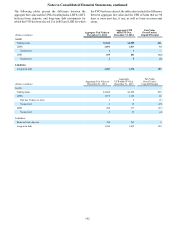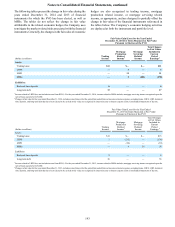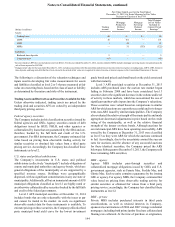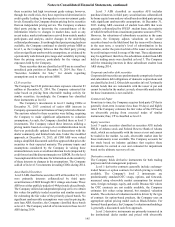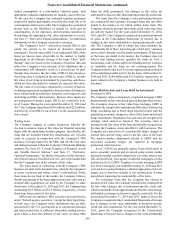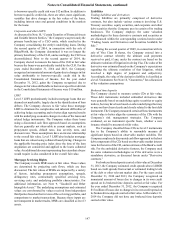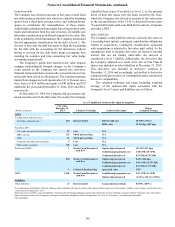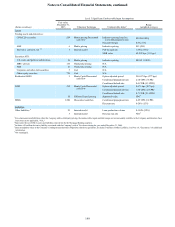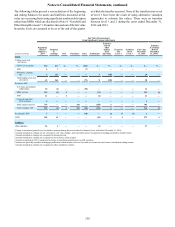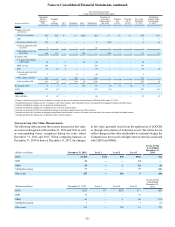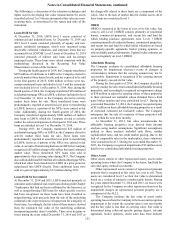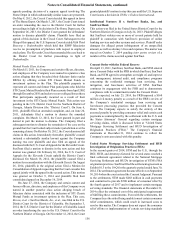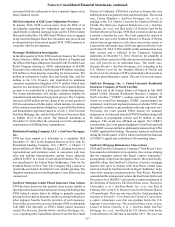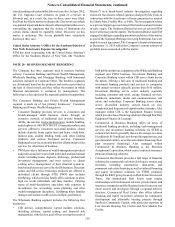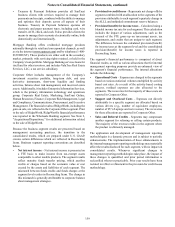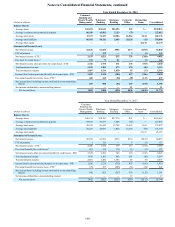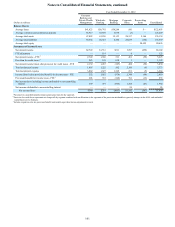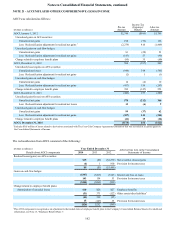SunTrust 2014 Annual Report Download - page 175
Download and view the complete annual report
Please find page 175 of the 2014 SunTrust annual report below. You can navigate through the pages in the report by either clicking on the pages listed below, or by using the keyword search tool below to find specific information within the annual report.Notes to Consolidated Financial Statements, continued
152
The following is a discussion of the valuation techniques and
inputs used in developing fair value measurements for assets
classified as level 2 or 3 that are measured at fair value on a non-
recurring basis, as determined by the nature and risks of the
instrument.
Loans Held for Sale
At December 31, 2014, LHFS level 1 assets consisted of
commercial and industrial loans. At December 31, 2014 and
2013 level 2 assets consisted primarily of agency and non-
agency residential mortgages, which were measured using
observable collateral valuations, and corporate loans that are
accounted for at LOCOM. Level 3 assets at December 31, 2014
consisted primarily of indirect auto loans and tax-exempt
municipal leases. These loans were valued consistent with the
methodology discussed in the Recurring Fair Value
Measurement section of this footnote.
During the fourth quarter of 2014, the Company transferred
$470 million of C&I loans to LHFS as the Company elected to
actively market these loans for sale, and are expected to be sold
in the first quarter of 2015; $340 million of these were tax-
exempt municipal leases included in level 3 and the remainder
were included in level 1 at December 31, 2014. Also, during the
fourth quarter of 2014, the Company transferred $38 million of
residential mortgage NPLs to LHFS, which are included in level
2 at December 31, 2014, as the Company elected to actively
market these loans for sale. These transferred loans were
predominantly reported at amortized cost prior to transferring
to LHFS; however, a portion of the NPLs were carried at fair
value. Additionally, during the fourth quarter of 2014, the
Company transferred approximately $600 million of indirect
auto loans to LHFS, which the Company elected to actively
market for sale in anticipation of a first quarter 2015 sale. These
loans are included in level 3 at December 31, 2014.
During 2013, the Company transferred $25 million of
residential mortgage NPLs to LHFS, as the Company elected to
actively market these loans for sale. These loans were
predominantly reported at amortized cost prior to transferring
to LHFS; however, a portion of the NPLs was carried at fair
value. As a result of transferring the loans to LHFS, the Company
recognized a $3 million charge-off to reflect the loans' estimated
market value. These transferred NPL loans were sold at
approximately their carrying value during 2013. The Company
also sold an additional $63 million of residential mortgage NPLs
which had either been transferred to LHFS in a prior period or
repurchased into LHFS directly. These additional loans were
sold at a gain of approximately $12 million during 2013.
Loans Held for Investment
At December 31, 2014 and 2013, LHFI consisted primarily of
consumer and residential real estate loans discharged in Chapter
7 bankruptcy that had not been reaffirmed by the borrower, as
well as nonperforming CRE loans for which specific reserves
had been recognized. As these loans have been classified as
nonperforming, cash proceeds from the sale of the underlying
collateral is the expected source of repayment for a majority of
these loans. Accordingly, the fair value of these loans is derived
from the estimated fair value of the underlying collateral,
incorporating market data if available. There were no gains or
losses during the years ended December 31, 2014 and 2013 as
the charge-offs related to these loans are a component of the
ALLL. Due to the lack of market data for similar assets, all of
these loans are considered level 3.
OREO
OREO is measured at the lower of cost, or its fair value, less
costs to sell. Level 2 OREO consists primarily of residential
homes, commercial properties, and vacant lots and land for
which binding purchase agreements exist. Level 3 OREO
consists primarily of residential homes, commercial properties,
and vacant lots and land for which initial valuations are based
on property-specific appraisals, broker pricing opinions, or
other available market information. Updated value estimates are
received regularly on level 3 OREO.
Affordable Housing
The Company evaluates its consolidated affordable housing
properties for impairment whenever events or changes in
circumstances indicate that the carrying amount may not be
recoverable. Impairment is recognized if the carrying amount
of the property exceeds its fair value.
During the first quarter of 2014, the Company decided to
actively market for sale certain consolidated affordable housing
properties, and accordingly, recognized an impairment charge
of $36 million to adjust the carrying values of these properties
to their estimated net realizable values obtained from a third
party broker opinion and were considered level 3. During the
year ended December 31, 2014, the Company recognized gains
of $15 million on these affordable housing properties as a result
of increased estimated net realizable values. The Company
anticipates that the sale of a majority of these properties will
occur within the next three months.
At December 31, 2013, fair value measurements for
affordable housing properties were derived from internal
analyses using market assumptions. Significant assumptions
utilized in these analyses included cash flows, market
capitalization rates, and tax credit market pricing. Due to the
lack of comparable sales in the marketplace, these valuations
were considered level 3. During the year ended December 31,
2013, the Company recognized impairment of $3 million on its
held for use consolidated affordable housing properties.
Other Assets
Other assets consist of other repossessed assets, assets under
operating leases where the Company is the lessor, land held for
sale, and equity method investments.
Other repossessed assets consist of repossessed personal
property that is measured at fair value less cost to sell. These
assets are considered level 3 as their fair value is determined
based on a variety of subjective unobservable factors. During
the years ended December 31, 2014 and 2013, no losses were
recognized by the Company on other repossessed assets as the
impairment charges on repossessed personal property are a
component of the ALLL.
The Company monitors the fair value of assets under
operating leases where the Company is the lessor and recognizes
impairment to the extent the carrying value is not recoverable
and the fair value is less than its carrying value. Fair value is
determined using collateral specific pricing digests, external
appraisals, broker opinions, recent sales data from industry


